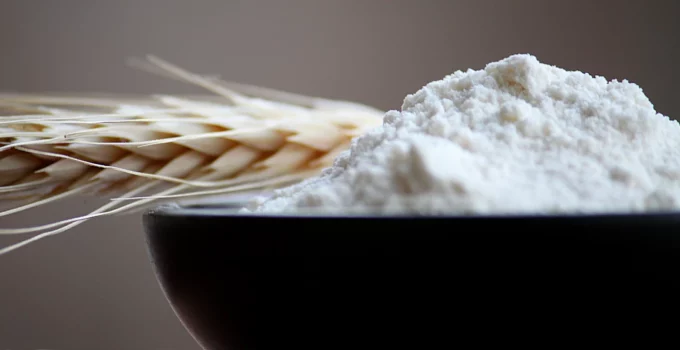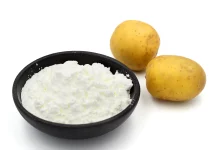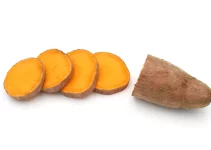Looking for spelt flour substitutes can be quite easy for people around the globe.
Thankfully, there are many flours that we can use to replace spelt flour. And most of these will be easily accessible no matter where you live.
As always, in order to understand which substitutes we should use, we must entirely understand what we’re trying to replace.
If we know our ingredients, we’ll also be able to understand which replacements would work for our specific recipe and which wouldn’t.
This applies whether we’re looking for substitutes for bulgur, potato starch substitutes or bacon grease substitutes, baking mat substitutes, aluminum foil substitutes, microwave oven alternatives, and many others.
What is spelt flour?
According to this website, spelt flour is often used as an alternative for all purpose flour or whole wheat flour.
And that’s how easy it was to come across two of the best spelt flour substitutes: all purpose flour and whole wheat flour or even a combination of the two. So that makes 3 substitutes.
Plus, these substitutes are the easiest and the most affordable flours to find around the globe so they’re among my favorites.
Spelt can be used for everything baking and cooking related. That also indicates that deciding on a spelt flour substitute for your particular recipe can be quite easy no matter which recipe we’re trying to make.
It is used for baking bread, muffins, waffles, cookies, etc.
Table of Contents
Spelt Flour Substitute: My Top 8 Recommendations
Spelt is an ancient grain that is primitive relative to wheat. It has been cultivated since 5000 BC. It is also referred to as dinkel wheat or hulled wheat. Plus, it’s a nice source of dietary fiber.
It is also a whole grain flour because it has all three parts of the kernel: bran, germ, endosperm. We also know that whole grains have more fiber, vitamins, and minerals than refined flours.
This website provides us with a list of whole grain flours. These include: amaranth, barley, brown rice, buckwheat, corn, millet, oats, quinoa, rye, and spelt.
Another thing we must take into account when we’re looking for a spelt flour substitute is the categorization of flours according to the gluten they contain or don’t contain.
Spelt flour has a high gluten content so it’s absolutely not gluten free.
Thus, we’ll have to see which replacements we can use if we’re looking for gluten-free substitutes because all purpose and whole wheat won’t work in that case. But they will work nicely for those who aren’t on a gluten-free diet.
The gluten free ones from that list are: amaranth, brown rice, buckwheat, corn, millet, and quinoa.
In the end, the idea is that we can use a whole array of flours, including gluten-free ones, as spelt flour substitutes.
It’s up to you to decide which flour would work best for your recipe, which will also be influenced by which flours are easily accessible and which match your budget.
1. All purpose flour
Bon Appetit mentions that spelt flour is like all-purpose flour with one difference, which they call an advantage: it tastes like something.
Of course there’s a taste difference. All purpose flour is refined, while spelt is a whole grain, an ancient grain relative to wheat.
Spelt flour tastes almost the same as wheat flour. It can have a nutty flavor, very similar to barley. It can be slightly sweeter with a pleasing nuttiness. Some people will also say that we can almost taste a little saltiness, a tiny bit of iron.
Even so, all purpose (AP) flour is my top recommendation as a spelt flour substitute for various reasons.
All purpose is one of the cheapest flours around the globe.
It’s also one of the easiest to find no matter where we live.
And it’s an ingredient that many people know how to bake and cook with.
Moreover, all purpose can be used in a number of ways: baking bread, making pizza, making desserts, coating meats, vegetables, and as a thickening agent for sauces and gravies.
It’s the type of flour that can really be used for everything we want. The only limitation is that it cannot be used by those who follow a gluten-free diet.
I recommend doing a 1:1 substitution.
2. Whole wheat flour
If you’re not into white, refined flours then you’re not going to like all purpose flour at all.
Well, there is another spelt flour substitute that is very easy to find, the price is pretty good, and it will work in whatever recipe you want to make.
If you want a substitute that is whole grain, that is made up of three parts: bran, germ, and endosperm, then whole wheat flour can be an amazing replacement for spelt.
Whole wheat flour is the perfect replacement for people who want to include more whole grains into their diets.
Well, whole wheat won’t work only as the perfect substitute for spelt flour.
It can also be used as a substitute for white flour in baking.
This guide shows us how we can replace white flour with whole wheat flour.
For replacing spelt, we make a 1:1 substitution.
It will pretty much work for all recipes.
If you are worried that using 100% whole wheat would be too much for your tastes, then you can use just 25% whole wheat and use white bread flour or all purpose to make up the rest. Thus, a gradual substitution can also work nicely for people who are beginners to whole grains in their diets. We can use them gradually until you get used to the new flavors. You’ll love it in no time.
3. Einkorn flour
If you want to substitute an ancient grain with another ancient grain, then we have einkorn flour as a spelt flour substitute.
Einkorn flour is produced from an ancient species of wheat that was domesticated roughly 12,000 years ago or maybe 5,000 years ago, depending where you read about it. The thing that matters is that it’s ancient, just like spelt. But I guess we could say that einkorn is known as man’s first wheat.
Emmer and spelt are also ancient wheat varieties. These three are considered farro, which is an Italian word for ancient hulled wheat.
And all these ancient wheat varieties can be made into flours that can serve as substitutes for our white flours, for all purpose flour.
And, in turn, all purpose flour is a substitute for them.
It just depends what type of flours you want to incorporate into your diet, that’s all that matters.
Einkorn comes from two German words that mean single grain. You can learn more about its benefits here.
We can make a 1:1 substitution.
4. Gluten free all purpose flour
If we can use all purpose flour in a 1:1 substitution with spelt flour for a diet that allows gluten, then we can also use its gluten-free counterpart for a diet that doesn’t allow gluten foods.
There are many gluten free flours that work as a 1-to-1 all purpose flour substitute.
Thus, these 1-to-1 gluten free all purpose flour swill also work as a substitute for other flours, like spelt.
However, if you’re not on board with this gluten-free solution, then stick around because just below I’m going to talk about amaranth flour, which is a gluten free flour made by grinding the seeds of the amaranth plant.
In terms of GF all-purpose flours, we have a number of options to choose from. These are pretty easy to find and their prices are decent.
We’ve got the Bob’s Red Mill Gluten Free 1-to-1 Baking Flour. We can use this blend in place of wheat flour in our favorite recipes for cookies, cakes, brownies, pancakes, pies, muffins, and more. Of course, we can also bake bread with it. This one from Bob’s Red Mill has the following ingredients: sweet white rice flour, whole grain brown rice flour, potato starch, whole grain sorghum flour, tapioca flour, xanthan gum.
Another one is the Cup4Cup Multipurpose Flour Gluten Free 1:1 All Purpose Flour Substitution. It is used in the same ways that we would use gluten flours and it works in a cup for cup substitution. Its ingredients are: cornstarch, white rice flour, brown rice flour, rBST-free milk powder, tapioca flour, potato starch, xanthan gum. It contains milk so it’s not a good choice for people who don’t consume milk and milk products.
The other alternative is to make your own gluten-free flour mix.
5. Amaranth flour
I can’t say that amaranth flour is my perfect idea of a gluten-free substitute for spelt flour. I’m not saying that it can’t work because it can certainly do.
However, what I’m saying is that amaranth flour can be a lot harder to find than the gluten-free all purpose flour options I mentioned above.
Besides being harder to find, it can also be significantly more expensive.
So, while amaranth flour is a gluten-free product that can work in a variety of recipes, I’m not so sure that many people would actually consider it due to its price and the fact that it’s not as easy to find across the globe.
Frankly, it’s so much easier to make your own gluten free flour mix. Or to just buy one ready made from a good manufacturer.
Amaranth flour has a mild but distinct nutty, earthy, slightly sweet, malt-like flavor.
Bob’s Red Mill recommends using amaranth in combination with whole wheat flour. But that won’t work if you’re making a GF recipe.
You can use amaranth in a 1:1 substitution for spelt or you can use it to make a more complex GF mix.
6. Rye flour
Rye flour is quite famous among certain bakers. It is especially popular among people making sourdough starter and baking sourdough goods.
The King Arthur Organic Rye Flour is a top choice for me when I’m making my starter.
The price is decent and the flavor is amazing. It is great for complex, flavorful breads and baked goods.
Well, besides making bread and sourdough bread, we can use rye flour for other baked goods like: pasta, crackers, scones, crispbread, gingerbread, fruitcakes, filler for soups and sauces, etc.
It won’t work for all desserts but it will work in some.
However, rye flour is not easy to bake with because it absorbs more water. It is rich in water-absorbent carbohydrates. It can hold ten or more times its weight in water, while wheat flour only absorbs twice its weight.
The substitution ratio is:
1 cup rye flour = ½ cup spelt flour
1 ½ cups rye flour = 1 cup spelt flour
However, I would also say that we can combine it with another flour to get the elasticity.
7. Almond flour
This can be great if you want to make gluten-free desserts and you also want an easy to use substitute for spelt flour.
Almond flour can be deliciously used in cookies, cakes, quick breads, pancakes, tarts, etc. It’s just great for desserts because it helps make baked goods tender and moist.
While we can buy almond flour for pretty decent prices, another advantage is that we can make our own almond flour at home if we have a decent blender. Or in a food processor.
Check out my reviews for the best flax seed grinders if you want to know more about blenders that can grinds all kinds of grains and seeds.
We can do a 1:1 substitution but you need to check if you need to add more liquid. Almond flour absorbs liquids just like white flour so that’s why it’s such an easy-to-use substitution.
8. Rice flour
While it’s certainly true that we can use rice flour to make some gluten-free recipes, this type is not as versatile as almond flour.
It can be good if we want to thicken soups and sauces. Or for making gluten free noodles. Or some pancakes.
However, on its own, rice flour has its limitations. That’s true for both white rice flour and brown rice flour.
Thus, I recommend incorporating this type into a gluten-free flour mix, that’s a much better use for it.
When I gave you my examples for the types of gluten free all purpose flours that we can use for a whole array of baked goods from bread to pizza dough to desserts, you might have noticed that these GF flours contain white rice flour and brown rice flour besides other types of GF flours.
Thus, if you have easy access to rice flour, I recommend incorporating it into a mix and so you can create your own spelt flour substitute.




